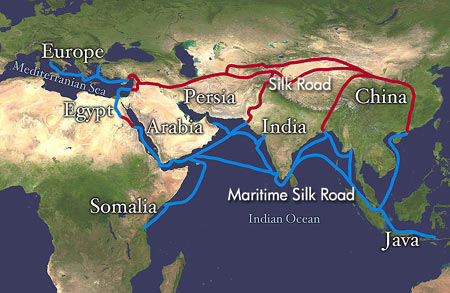Maritime Silk Road
 |
|
Click for larger view |
The maritime Silk Road, like its overland counterpart, had its origins during the Han Dynasty (202 BC-220 AD). Although vast seas separate the four corners of the Earth, with advances in shipbuilding and navigational technologies, maritime transport came to provide unprecedented access to the most distant destinations.
It is known that the bulk of the raw and processed silk transported along the overland Silk Road during the Han Dynasty was produced primarily along China's southern coast and in the coastal Wu, Wei, Qi, and Lu regions (present-day Shandong Province). Since ancient times, these areas have been thriving centers of shipbuilding as well as silk production. They were thus able to supply both commodities for export and the means to transport them across the sea. It was this combination that provided the social and material conditions necessary for the development of maritime trade during the Han Dynasty.
The maritime routes opened by Emperor Han Wudi (reigned 140-87 BC) provided access to the Roman Empire via India, marking the first oceanic route as well as the earliest maritime trading route in the world. This enabled China to actively seek out overseas markets and establish foreign trade relations, and laid the foundation for the development of the maritime Silk Road.
Han Shu Record (also known as The History of the Han Dynasty) kept the first complete vivid record on China's boats sailing into the Indian Ocean from the South Sea via the Malacca Strait in Southeast Asian waters. Han ships would leave from Xuwen in South China's Guangdong Province, or Hepu in South China's Guangxi Zhuang Autonomous Region, and via the South Sea, would arrive in India and Sri Lanka -- a transfer station, where pearls, colored glazes, and other exotic things could be bought. Chinese silk was transported to Rome hereafter. Such was the maritime Silk Road.
In his book Nature History, Gaius Plinius Secundus, a knowledgeable scientist in ancient Rome, recorded, "four sailors from (today's Sri Lanka) left for Rome (during the Caesar Era). According to one of the sailors named Rutgers, both Rome and Sri Lanka had direct trade relations with China."
In 166 of the Han Dynasty, the Roman Emperor sent envoys to China, presenting various such gifts as ivory and hawksbill turtles to the imperial royal court, which marked the earliest friendly relations between China and European countries. A direct route from the East to the West was therefore opened up.
During the Tang Dynasty (618-907 AD), Chinese ships set sail from Guangzhou, bound across the South China Sea, thus pioneering the most important routes of the maritime Silk Road. In addition to transporting silk, the South China Sea routes stimulated both material and cultural exchange. Countries throughout Southeast Asia, South Asia, West Asia, and even Europe dispatched emissaries to China via the new maritime routes to establish diplomatic relations, purchase silk, and engage of trade of all sorts. Silk, as the principal maritime trade commodity, flowed in a steady stream from China to other countries.
Profits from the maritime trade were one of the Chinese government's major sources of revenue during this time. The Tang, Song (960-1279), and Yuan (1279-1368) Dynasties all appointed special Commissions of Maritime Affairs at coastal cities including Guangzhou (Canton), Mingzhou (present-day Ningbo), and Quanzhou. These offices were responsible for overseeing maritime trade and providing logistic support and preferential treatment for foreign merchants in China. The maritime Silk Road thus became a conduit for promoting friendly relations and linking East and West.
 0
0 







Go to Forum >>0 Comments